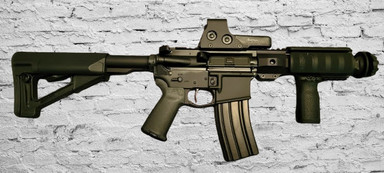May 2nd 2025
Understanding SBRs (Short-Barreled Rifles): What You Need to Know
If you're diving deeper into the world of tactical firearms, chances are you've come across the term SBR, or Short-Barreled Rifle. These compact, powerful firearms are popular among enthusiasts for their maneuverability and aesthetics—but they also come with strict legal regulations. Here’s what every shooter should know before buying, building, or using an SBR.
What is an SBR?
An SBR, or Short-Barreled Rifle, is defined by the Bureau of Alcohol, Tobacco, Firearms and Explosives (ATF) as:
-
A rifle with a barrel shorter than 16 inches, or
-
A firearm with an overall length under 26 inches, that is designed to be fired from the shoulder and uses rifle ammunition.
This sets it apart from pistols (no stock, not designed to be shouldered) and rifles (longer barrels). SBRs combine elements of both, offering the precision and power of a rifle in a more compact frame.
Why Choose an SBR?
-
Compact Size: Easier to maneuver in tight spaces, vehicles, or for home defense.
-
Customization: Many SBRs are based on AR-15 platforms, allowing for extensive personalization.
-
Suppressed Builds: Popular for pairing with suppressors due to reduced overall length.
-
Tactical Aesthetics: SBRs often resemble military carbines—appealing to many enthusiasts.
Legal Considerations
Under the National Firearms Act (NFA), SBRs are highly regulated:
-
Registration with the ATF: All SBRs must be registered through an ATF Form 1 (for builds) or Form 4 (for purchases).
-
$200 Tax Stamp: A one-time fee for registration.
-
Wait Time: Can range from a few weeks (eForms) to several months.
-
Transport Restrictions: Traveling across state lines with an SBR requires prior ATF approval.
⚠️ Warning: Building or possessing an unregistered SBR is a felony. Even temporarily attaching a stock to a pistol with a short barrel qualifies as an SBR under federal law.
SBR vs. Pistol: Know the Difference
AR pistols are often mistaken for SBRs. The key difference is:
-
AR Pistol: No stock, typically has a brace (when legal), not intended to be shouldered.
-
SBR: Has a shoulder stock and is designed to be fired from the shoulder.
This distinction became murky in recent years with pistol braces, but current ATF rulings have reclassified many brace-equipped firearms as SBRs—requiring compliance.
How to Legally Obtain an SBR
There are two legal pathways:
-
Buy an SBR from a Dealer:
-
Must be an FFL with SOT.
-
You’ll complete ATF Form 4 and wait for tax stamp approval before taking possession.
-
-
Build Your Own (Form 1):
-
Start with a stripped lower or pistol lower.
-
Submit an ATF Form 1 online.
-
Wait for approval and receive your tax stamp.
-
Only then can you assemble the SBR.
-
Final Thoughts
SBRs offer incredible versatility and performance for those who understand the rules. Whether you're upgrading your tactical setup or expanding your collection, make sure your build or purchase is 100% compliant. When done right, owning an SBR is a rewarding experience that adds firepower and flexibility to your arsenal.
Disclaimer: This article is for informational purposes only and should not be considered legal advice. Always consult the ATF or a licensed attorney for questions regarding firearm laws in your state or jurisdiction.
